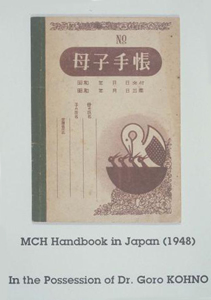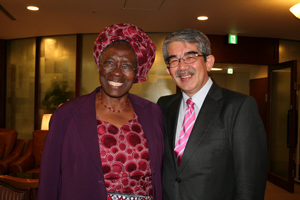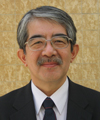1. Introduction
The Health and Development Service (HANDS) is a non-profit organization which supports developing countries through its aid for the establishment of healthcare schemes and human networks. HANDS is currently engaged in activities to improve healthcare services for communities, mainly in Kenya and Papua New Guinea. It also hosts international symposiums and training sessions to support people who are working to disseminate the maternal and child health (MCH) handbook in their own countries by reference to the Japanese MCH handbook and its framework.
2. The Japanese "Maternal Child Health Handbook"
A maternal and child health (MCH) handbook (commonly Boshi Techo or formally Boshi Kenko Techo in Japanese, meaning a handbook of mothers and children) is issued to a prospective mother when she registers her pregnancy. The MCH handbook records the medical check results of the pregnant woman as well as the chronicle data of the infant's well-being after birth, such as weight, height and immunization records. In Japan, it is a common habit to have a MCH handbook when a woman becomes pregnant. However, there are only a few countries that issue a single booklet of health records of mothers and children from the pregnancy stage to the stage of early childhood.
Throughout the world, there are various forms of media for family records. In the USA and the UK, organizations such as the pediatric society provide a booklet to record the medical check results of children, their growth curve and immunization history. However, there is no medium to record the health conditions of mothers. In France, a health handbook is issued for women and new-born babies/young children separately. In many of the developing countries, a child health card is widely used, which keeps track of the child's immunization history and growth curve. However, this card is just a simple piece of paper and may be easily mislaid.
In this regard, the Japanese MCH handbook is unique since mothers can maintain the handbook by themselves. It chronicles the health conditions of both mothers and children starting from the stages of pregnancy and childbirth through to the stage of early childhood.

The majority of the pages were used to record baby formula and sugar rations which at that time were provided for pregnant women and babies on a monthly basis.
The handbook contains only 20 pages with no color; it was written by hand and then mimeographed. The paper quality was not very good, since paper was still subject to rationing at that time. There is an episode that the Health and Welfare Ministry had difficulties in procuring printing paper for the MCH handbook.
The photograph was kindly provided by Dr. Goro Kohno (who worked for the Health and Welfare Ministry at that time).
3. The MCH Handbook is a Miracle!
The MCH handbook offers various benefits. Parents can utilize the handbook to manage the records written in it; to change a medical institution; to have better communications with healthcare service providers; and to gain more knowledge and improve behavior and activities as healthy parents. This Japanese MCH handbook is now drawing attention from developing countries.
Several initiatives inspired by the Japanese MCH handbook have been implemented reflecting specific cultures and social/economic conditions in each country with support from the Japan International Cooperation Agency (JICA), UNICEF, and other NGOs.
In September 2015, the 9th International Conference on the MCH Handbook was hosted jointly by the Cameroon Health Department in the Republic of Cameroon, Africa, and International Committee on MCH handbook. The conference received support and cooperation from various organizations in Japan, including the Ministry of Foreign Affairs of Japan, the Cabinet Office, the Ministry of Health, Labour and Welfare, the JICA, the Japan Medical Association, and private companies. Most expenses for the conference were borne by the Cameroon Health Department, apart from the transportation expenses of foreign participants. At the opening ceremony, eight ministers and vice ministers including the health minister attended. This was broadcast on TV and radio on consecutive days, drawing great attention from the public of Cameroon. The conference was held for three days, interpreted simultaneously in English and French, and around 250 people attended from twenty English/French-speaking African countries including Cameroon. Some countries have already introduced the MCH handbook, while other countries are just planning to introduce it. The attendees actively participated in the conference, by reporting their country's initiatives regarding the MCH handbook and sharing passionate opinions with each other. A specialist in Cameroon who manages the use of the MCH handbook in four states received advice on how to disseminate the handbook from the personnel of the Indonesian Health Department. In this way, the conference provided a good opportunity to share opinions and information among people from developing countries.
A woman cabinet member who attended the opening ceremony made this comment: "The Cameroon government is implementing various initiatives focusing on the empowerment of women in the fields of agriculture and education. However, there are a large number of women in Cameroon who die during pregnancy or childbirth. I do hope that use of the MCH handbook will improve the health conditions of mothers and children, and thus help more women actively participate in society after childbirth." Her comment indicates that the MCH handbook was introduced by taking into account different social/economic conditions of each country as well as the hopes of families from various cultures.
Some members of the Ministry of Public Health and directors of hospitals who attended the conference were keen to discuss the MCH handbook, saying: "The MCH handbook is a miracle tool" (Photograph 2). Why do academic experts in the developing countries give unstinting praise to the MCH handbook? Thinking back on the post-war history of Japan, the nation has successfully changed its status from one of a developing country to a country having one of the lowest mortality rates of newborns and infants and the longest average life expectancy. This was a result of the great efforts made by forerunners who created the excellent national welfare systems. In the field of maternal and child health, in particular, technology and know-how developed before the period of Japan's high economic growth were utilized effectively. These things do not require high expenditure and advanced medical treatments, since they were developed by forerunners who, by necessity, had to manage with insufficient manpower and budgets; therefore, much of this technology and know-how can be applied to developing countries. I believe that it is one of the important international collaborations to disseminate Japan's valuable experiences and wisdom such as the MCH handbook, the universal healthcare system, and the sickbay at elementary and junior high schools.

She says that the MCH handbook is not a mere booklet of health records but a miracle tool to realize the empowerment of women in society.
Dr. Were was the recipient of the First Hideyo Noguchi Africa Prize. She served as Director at the Faculty of Medicine, University of Nairobi, and Director of the United Nations Population Fund Country Support Team in Ethiopia. She established the UZIMA Foundation, developed the capabilities of communities and youth, and improved the quality of social systems for the entire society. She has been a symbol of hope for all people living in the continent of Africa over the years.
4. How to Disseminate the MCH Handbook to Many Countries
Healthcare represents the culture of a country. Therefore, it is difficult to disseminate Japan's MCH handbook, which was developed based on the culture of Japanese healthcare, by trying to export the handbook as it is to other countries. Instead, it is necessary to develop the MCH handbook to make it suitable for the healthcare systems and healthcare service providers of each country, as the saying goes "When in Rome, do as the Romans do." No matter how well the MCH handbook may be created, it will not be utilized by the doctors and nurses in the country unless they feel they want to use the handbook for medical records and mothers feel they want to keep it for medical checks and immunizations.
The most important factor in introducing the MCH handbook was to refrain from merely translating the Japanese handbook. In each developing country, beautiful posters and leaflets for health education programs have already been prepared, in addition to medical checks for pregnant women, children's growth curve such as their height and weight, and immunization records. We are trying to utilize such materials and records to the greatest extent possible, and create the MCH handbook with more colorful pictures/illustrations and keep text to a minimum, considering the educational background and literacy level of mothers. In the case of illiterate mothers, if there is any family member who can read the handbook, the intent of the handbook can be fully understood and utilized.
It is also important to consider costs and financial aid when introducing the MCH handbook. There will be two main cost areas: training costs for healthcare-related personnel, and printing costs for the handbook to be incurred annually. These costs may be covered by aid from international organizations and donor organizations at the time of introducing the handbook, but the main issue is how to finance the annual cost of printing. In my experience, the probability of covering the annual printing cost will increase if the printing cost per handbook can be kept under one US dollar. In recent years, private companies in some countries and regions are providing support for the printing cost, by calling for a public private partnership (PPP) and publishing enlightenment messages and advertisements.
Another major topic in recent years is the digitization of the MCH handbook. The use of mobile phones is increasing in the rural areas of Asian countries and Africa. People use them not only as a communication tool but also to transfer money. There are initiatives to utilize the digitized MCH handbook as well as the paper-based one, by effectively leveraging such an Information and Communication Technology (ICT) that becomes increasingly popular in people's daily lives.
To disseminate the MCH handbook, we should reaffirm the spirit of Onko-chishin (a proverb meaning "Things present are judged by the things past."). We need to value the tradition of the MCH handbook, which was created during the difficult times after the war, but also further develop the handbook reflecting the actual conditions and needs of each community, including the new challenge of digitizing the handbook. In this way, the handbook will become the most valuable gift for the children of tomorrow not only in Japan but also on a mass global scale.
The 10th International Conference on MCH Handbook is planned for the 23rd-25th November, 2016 in Tokyo. The main theme of the conference is the "MCH Handbook that offers MCH services for disabled people, refugees, immigrants, ethnic minority, the indigent and others, Leaving No One Behind." I will report on the outcome of the conference in the next session.



 Yasuhide Nakamura
Yasuhide Nakamura










